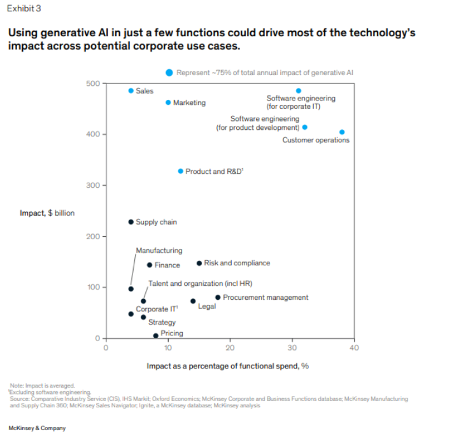Introduction
What is Generative AI? Generative AI refers to artificial intelligence that is typically developed using foundational models and possesses capabilities that previous AI models lacked, such as the ability to generate content. Foundational models can also be used for non-generative purposes (e.g., classifying user sentiment as positive or negative based on call transcripts) and offer significant improvements over previous models. Simply put, when we refer to Generative AI in this article, we include all use cases of foundational models.
The emergence of Generative AI has sparked excitement across various industries, promising immense potential to revolutionize productivity and drive economic growth. According to our latest research, this innovative technology could contribute trillions of dollars annually to the global gross domestic product (GDP).
In this blog post, we will examine key insights based on a recent analysis by McKinsey* and discuss the profound impact that generative AI will have on various domains, the future of work, and the associated challenges.
1. Unlocking Trillions of Dollars in Value:
Our research estimates that Generative AI could generate an impressive value of $2.6 trillion to $4.4 trillion annually across the 63 analyzed use cases. To put this into perspective, this figure exceeds the entire GDP of the United Kingdom in 2021. Furthermore, integrating generative AI into existing software applications beyond these use cases could potentially double this estimate, further amplifying the impact of artificial intelligence.
2. Value Creation in Key Areas:
Approximately 75 percent of the value generated by Generative AI comes from four crucial domains: customer service, marketing and sales, software development, and research and development. Within these domains, the technology enables companies to address specific challenges and achieve measurable results. Examples include improving customer service interactions, generating creative marketing content, and automatically generating computer code based on natural language inputs.
3. Impacts Across All Industries:
Generative AI is not limited to a single sector; it has significant potential across various industries. Industries expected to experience the highest revenue growth through the adoption of generative AI include banking, high-tech, and life sciences. In banking, for example, the technology could generate an additional value of $200 billion to $340 billion annually if the use cases were fully implemented. Retail and consumer goods also hold significant potential, with annual impacts ranging from $400 billion to $660 billion.
4. Reshaping the Workforce:
Generative AI has the potential to fundamentally transform the workforce by expanding individual employees’ capabilities and automating specific tasks. Current generative AI technologies, in conjunction with other automation tools, can automate up to 60 to 70 percent of employees’ current work activities, allowing them more time for more challenging tasks. This automation potential primarily stems from generative AI’s increasing ability to understand natural language, making it particularly impactful in knowledge-based professions.
5. Accelerating Workforce Transformation:
Due to advances in technological automation, including generative AI, the transformation of the workforce is expected to accelerate. Our updated scenarios for application development, economic feasibility, and diffusion indicate that between 2030 and 2060, approximately half of today’s work activities could be automated, with the midpoint falling in 2045. This forecast is approximately a decade earlier than previously estimated, highlighting the rapid progress of automation technologies.
6. Boosting Work Productivity:
Generative AI has the potential to significantly enhance work productivity in the economy. By leveraging this technology and supporting employees in adapting to new tasks or transitioning to new fields, annual labor productivity growth of 0.1 to 0.6 percent could be achieved by 2040. In combination with other technologies, the automation of work tasks could contribute an additional 0.2 to 3.3 percentage points to productivity growth.
However, it is important to provide employees with the necessary support and training to acquire new skills and navigate the transition.
7. Challenges on the Horizon:
While the prospects for Generative AI are undoubtedly fascinating, several challenges need to be addressed. Business and societal leaders must navigate the risks associated with this technology, anticipate the necessary skills and competencies for future workforces, and reconsider fundamental business processes such as reskilling and developing new capabilities.
Value Potential by Enterprise Functions
While Generative AI could have impacts across most enterprise functions, a handful stands out when considering the technology’s influence as a share of functional costs (see Figure 3). A recent McKinsey analysis across 16 enterprise functions found that only four of them—customer service, marketing and sales, software development, and research and development—could potentially account for around 75 percent of the total annual value generated by Generative AI use cases.
*McKinsey analysis based on data from various sources

In this blog article, I would like to take a closer look at the impact on the customer service domain and have gained the following insights:
The Transformation of Customer Service Activities through Generative AI
Generative AI has the potential to fundamentally change customer service by improving the customer experience and increasing agent productivity. Significant operational improvements in customer service can be achieved through digital self-service and agent support.
Generative AI enables customer interactions through human-like chatbots that provide instant and personalized responses to complex inquiries. This ensures a consistent brand voice regardless of the customer’s language or location. During customer-agent interactions, Generative AI supports human agents by providing real-time suggestions and assistance during phone conversations. Agents can instantly access relevant customer data to deliver tailored and timely information. Agents receive summaries of conversations to capture customer complaints and actions taken. Additionally, they can utilize automated personalized insights, such as tailored follow-up messages or coaching recommendations. The application of Generative AI in customer service has shown promising results. For example, companies with 5,000 customer service agents experienced a 14% increase in solution rate per hour and a 9% reduction in processing time per inquiry. The technology also reduced employee turnover and requests to speak with a supervisor by 25%. In particular, less experienced agents benefited from AI support as they were able to utilize effective communication techniques similar to more experienced agents.
Concrete Use Cases - Speech Genius
Generative AI can bring operational improvements in specific use cases in customer service. For example, automated chatbots can handle a higher percentage of customer inquiries, allowing the customer service team to focus on requests that require human intervention. Generative AI also enables instant access to customer data, reduces response time, and boosts revenue by providing personalized product recommendations based on customer preferences. In addition, with the daenet Speech Genius, we can offer a speech-to-text tool that not only transcribes texts but also provides simultaneous translation and detailed analysis.
In the next blog, I will specifically address the impact on marketing and sales. Stay tuned!
Source: McKinsey Study from 2023: The economic potential of generative AI: The next productivity frontier
